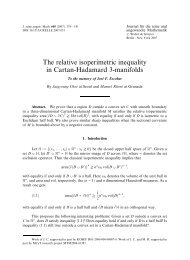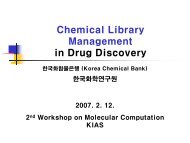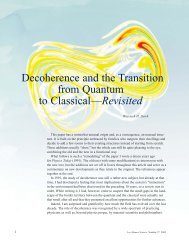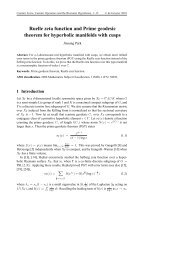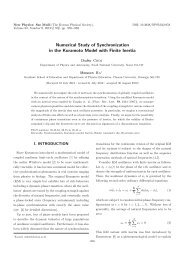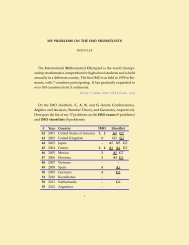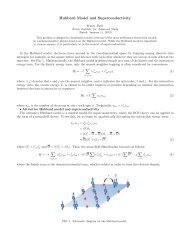A Quantum Kirwan Map: Bubbling and Fredholm Theory for ... - KIAS
A Quantum Kirwan Map: Bubbling and Fredholm Theory for ... - KIAS
A Quantum Kirwan Map: Bubbling and Fredholm Theory for ... - KIAS
Create successful ePaper yourself
Turn your PDF publications into a flip-book with our unique Google optimized e-Paper software.
12 1. MOTIVATION AND MAIN RESULTSbundle is made part of the data <strong>for</strong> a vortex. 34 More generally, it is possible topull back vortex triples (P,A,u) by a Kähler trans<strong>for</strong>mation of a Riemann surfaceequipped with a compatible area <strong>for</strong>m.Another motivation is the following: If the area <strong>for</strong>m or the complex structureon the surface Σ vary, then in the limit we may obtain a surface Σ ′ with singularities.It does not make sense to consider P as a bundle over Σ ′ . One way of solving thisproblem is by decomposing Σ ′ into smooth surfaces, <strong>and</strong> constructing smooth G-bundles over these surfaces. Hence the G-bundle should be viewed as a varyingobject.Once P is made part of the data, it is natural to consider equivalence classes oftriples (P,A,u) ∈ ˜M (as defined in (1.15)), rather than the triples themselves. Onereason is that all important quantities, like energy density <strong>and</strong> energy, are invariant(or equivariant) under equivalence. Note also that the bubbling <strong>and</strong> <strong>Fredholm</strong>results are more naturally stated <strong>for</strong> equivalence classes of vortices. Viewing theequivalence classes as the fundamental objects also matches the physical viewpointthat the “gauge field”, i.e., the connection A, is physically relevant only “up togauge”. ✷6. Remark. Let Σ be the plane C, equipped with the st<strong>and</strong>ard area <strong>for</strong>mω 0 , <strong>and</strong> consider the trivial G-bundle P 0 := C × G. Then the solutions (A,u) ofthe vortex equations (1.8,1.9) on P 0 bijectively correspond to solutions (Φ,Ψ,f) ∈C ∞( C,g × g × M ) of the equations(1.34)(1.35)∂ s f + L f Φ + J(f)(∂ t f + L f Ψ) = 0,∂ s Ψ − ∂ t Φ + [Φ,Ψ] + µ(f) = 0.Here we denote by s <strong>and</strong> t the st<strong>and</strong>ard coordinates in C = R 2 , <strong>and</strong> in the secondequation we identify the Lie algebra g with its dual via the inner product 〈·, ·〉 g .The correspondence maps such a triple (Φ,Ψ,f) to ( A,u ) , where A denotes theconnection on P 0 defined byA (z,g) (ζ,gξ) := ( Φ(z)ds + Ψ(z)dt ) ζ + ξ, ∀ζ ∈ T z C, ξ ∈ g, z ∈ C, g ∈ G,<strong>and</strong> the map u : P 0 → M is given by u(z,g) := g −1 f(z). The group C ∞ (C,G) actson the set ˜M 0 of solutions of (1.34,1.35) by()h ∗ (Φ,Ψ,f) := h −1 ∂ s h + Ad h −1Φ,h −1 ∂ t h + Ad h −1Ψ,h −1 f ,where we denote the adjoint representation of an element g ∈ G by Ad g : g → g.This group naturally corresponds to the gauge group C ∞ G (P 0,G), <strong>and</strong> its action tothe actiong ∗ (A,u) := ( g −1 dg + Ad g −1A,g −1 u ) .Since every G-bundle over C is trivializable, it follows that the quotient of ˜M0by the action of C ∞ (C,G) bijectively corresponds to the quotient M = ˜M/ ∼,consisting of gauge equivalence classes of triples (P,A,u) of solutions of (1.8,1.9).Hence the results of the present memoir can alternatively be <strong>for</strong>mulated in termsof solutions of the equations (1.34,1.35). However, the intrinsic approach usingequations (1.8,1.9) seems more natural. ✷34 Given a G-bundle P over C, we may of course choose a trivialization of P, <strong>and</strong> then definea pull back <strong>for</strong> pairs (A, u), using the trivialization. However, this approach is unnatural, since itdepends on the choice of a trivialization.



